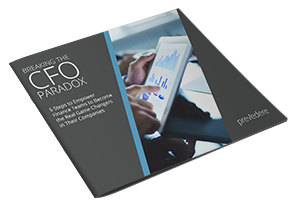Last Updated: January 12, 2021
Given the range of business intelligence software solutions on the market, it is vital that companies carefully consider what features they need before making investments.
Some business intelligence software products carry high costs and offer features most users will not need, while others are unwieldy and hard to use. Finally, some BI and analytics tools lack the capability to consider external and global information, limiting the accuracy of their results.
Decision makers need to consider all of these factors before they spend money on BI software tools that will not ultimately fulfill their needs. They must also consider the time and internal resources necessary to support their new software investment.
Evaluating a Business Intelligence Software Investment
Asking the right questions before making a costly BI investment will go a long way toward ensuring companies receive maximum value out of their software. To help finance leaders decide what business intelligence software solution is right for their organization, here are a few pivotal questions to answer:
1. Will this BI software enable our business to make critical decisions?
There is no shortage of enterprise data in the market. The ‘digital era’ means companies can better track inventory, manufacturing, sales, marketing efforts and more.
 Yet many finance leaders report uncertainty over their capacity to fully leverage that data amid an increasingly globalized, competitive and connected world, according to a new report from Workday.
Yet many finance leaders report uncertainty over their capacity to fully leverage that data amid an increasingly globalized, competitive and connected world, according to a new report from Workday.
With so much data to consider, it is sometimes difficult to determine what data is junk and what is valuable. Many finance leaders have found one way to manage this problem is to use software that employs machine learning capabilities to source, review and clean data – allowing them to spend more time considering critical decisions.
The best software is only as good as those who use it. Before making a software decision, consider how it will support strategic dialogue. Does it encourage collaboration? Will it better engage each stakeholder?
- Increase the speed of decisions
- Prompt teams to consider information in new ways
- Assist managers to become more informed and confident about their decisions
Teams should look for BI software that offers real-time validation capability to check these boxes. Using these insights, operations, finance and the executive team can come to an agreement on forecasts that are reasonable and achievable.
2. Does this software provide more data-driven insights?
It is all too common for internal teams to spend the majority of their time answering ad-hoc requests and questions focused on historical performance. Because of this limited exposure to both future trends and outside data, finance executives not only grasp, but make logical leaders decide which functions within the business need more fact-based information.
 Forecasting on internal and/or historical data alone is an outdated tactic that does not provide a holistic view of what truly drives businesses. Companies incorporating external data within planning and forecasting projects will discover patterns impacting business performance that have been previously hidden and unknown. This will lead to accurate and reliable performance forecasting. Ultimately this will also provide invaluable insight and information into the underlying reasons behind forecasts.
Forecasting on internal and/or historical data alone is an outdated tactic that does not provide a holistic view of what truly drives businesses. Companies incorporating external data within planning and forecasting projects will discover patterns impacting business performance that have been previously hidden and unknown. This will lead to accurate and reliable performance forecasting. Ultimately this will also provide invaluable insight and information into the underlying reasons behind forecasts.
Reflecting on external data analytics tools and science-driven approach to forecasting, Dr. Barry P. Keating, professor of economics and business analytics in the Department of Finance at the University of Notre Dame, explains how greater forecasting accuracy offers value across an organization “Notre Dame uses Prevedere in the college of business for students interested in going into analytics. That’s virtually every student, whether it is marketing, management, accounting, finance; every area uses analytics,” said Dr. Keating.
3. Will our investment maximize employees productivity?
To achieve maximum productivity, it is important that everyone is equipped with the same set of tools. Teams need software that operates across devices, references the same sets of data and integrate with other commonly used tools.
For most businesses, that means a cloud-based tool will be the best choice.
Cloud-based services offer significant advantages. First, data sets and models can be saved externally, making sure everyone is using the same points of reference. Second, cloud-based BI solutions may offer machine learning and predictive analytics capabilities that can automate routine tasks, freeing up more time for strategic, big-picture thinking.
For a more in-depth discussion of the advantages of cloud-based predictive analytics and forecasting, watch this Host Analytics webinar.
